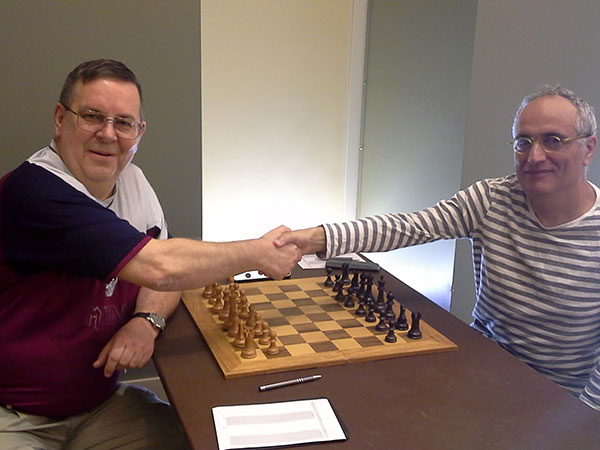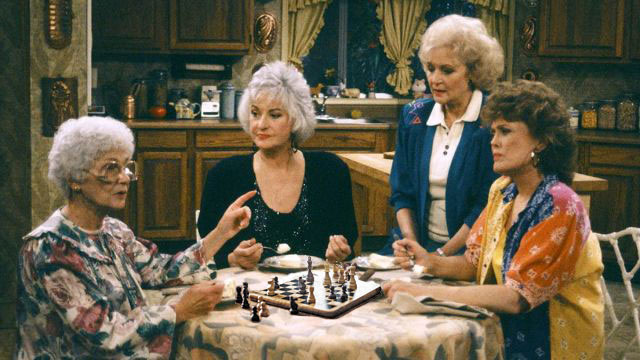


The U.S. Senior Championship is a new annual national tournament, sponsored in its inaugural year by the Saint Louis Chess Club and authorized by US Chess. The US Chess Executive Board created the U.S. Senior Championship on January 17, 2019, via email vote on motion EB19-053 by Chuck Unruh (US Chess Vice President of Finance). The U.S. Senior Championship is a 10-player round robin, with player selections by US Chess ratings (7), the previous year’s winner of the U.S. Senior Open (1), the previous year’s winner of the National Senior Tournament of Champions (1) and a Wildcard selection by the sponsor, Saint Louis Chess Club (1).
The U.S. Senior Championship will have a USD $50,000 prize fund and will be held in July of 2019, according to the Executive Director of the Saint Louis Chess Club, Tony Rich. He spoke about the new tournament in an interview during the recent Cairns Cup.
Saint Louis Chess Club YouTube
In 2016, the US Chess Executive Board added $2,000 to the U.S. Senior Open. That is, a $500 travel stipend to the highest finishing U.S. flagged players in U.S. Senior Open in each of four categories—open age 50 and up, open age 65 and up, female age 50 and up and female age 65 and up. The travel stipend is only to be used to offset costs to participate in the succeeding World Senior Championship or Women’s World Senior Championship. The motion was first presented to the Executive Board by its then-member WGM Anjelina Belakovskia. But the final wording was by Allan Priest, now the President of the US Chess Executive Board. Search for motion “EB16-042” in the 2016 Delegates Call (PDF).
Belakovskaia introduced EB17-052, a motion to support a US Chess Senior Team participating in the FIDE World Senior Team Championship (ages 50+). For 2018 and 2019, the US Chess Senior Team receives $3,000 per player, with a maximum of $15,000. Since five players went to Dresden in 2018, $15,000 was budgeted. That US Chess Senior Team won the gold medal in the 50+ open division.

The winning USA team: Sergey Kudrin, Joel Benjamin, Jaan Ehlvest, Alexander Shabalov (not pictured: Alex Yermolinsky) | Photo: Karsten Wieland
The next FIDE World Senior Team Championship is April 2019, in Rhodes (PDF). In Rhodes, the U.S. Chess Senior Team will compete for a first prize, in the overall division of ages 50 and over, of €1300 (2nd team: €900, 3rd team: €600, 4th team: €500, 5th team: €400). US women ages 50 and older are not high enough rated to qualify for that overall US Chess Senior Team. The US Chess Executive Board did not fund a US Chess Senior Women’s Team, though the FIDE World Senior Team Championship offers a first place prize for a women’s team, ages 50 and over, of €600 (2nd women: €400, 3rd women: €300).
US Chess provided up to $10,000 in funding for the inaugural 2018 National Tournament of State Senior Champions and a similar level of funding is planned for 2019. See motions EB18-024 and EB18-038 by Unruh in the 2018 Delegates Call (PDF). Participants completing all rounds of the National Tournament of State Senior Champions are eligible for a reduced entry fee into the concurrent U.S. Open. The Internet Chess Club provided two years of free membership to participants in the 2018 National Tournament of State Senior Champions.
To select its “state senior champion,” each state either held a qualifying tournament or chose its highest-rated senior. From what I can determine, no state picked a woman representative. The photos of the 2018 participants show 42 men.
No women played in that inaugural National Tournament of State Senior Champions. As of 2019, one woman has claimed a $500 travel stipend from the U.S. Senior Open to continue on to the Women’s World Senior Championship. And, as noted, US Chess does not fund a women’s team to the FIDE World Senior Team Championship. Therefore, women have not yet joined the “golden age” of US Chess for players ages 50 and over.
Fill in the blank: U.S. Junior Championship, U.S. Girls’ Junior Championship. U.S. Championship, U.S. Women’s Championship. U.S. Senior Championship, ______________. I filled that blank with “U.S. Senior Women’s Championship.” Disclosure: Were it to be created, I would play in a U.S. Senior Women’s Championship. To fulfil activity requirements, in place for all US Chess invitational tournaments, potential U.S. Senior Women’s Championship participants would necessarily become visible as tournament chess players.
Currently, women ages 50 and older are almost invisible as US Chess tournament players. Women ages 50 and older are the most under-represented group of US Chess members compared to their numbers among the general US population. (Except for babies and toddlers, who are also under-represented in US Chess. But presumably it is better to attract older women to chess tournaments than to have babies at the boards.) Women ages 50 and older are also under-represented, compared to other age groups, among the over 13,000 female members of US Chess.
As I initially discussed in an article titled "U.S. Senior Women’s Championship?", few older women play US Chess-rated tournaments and those that do have, on average, lower ratings than senior men. Mike Nolan, IT Consultant for US Chess, provided the following statistics. There were 167 female players ages 50 and older (120 with established ratings — ratings based on more than 26 US Chess regular-rated games — and 47 with provisional ratings) who played at least one regular-rated game in the 12 US Chess ratings lists issued for 2018. During that same year of 2018, there were 5557 men ages 50 and older with an established rating (and 723 with a provisional rating) who played at least one regular-rated game during 2018. Regular-rated means the games were at least 30 minutes per side per game.

WGM Camilla Baginskaite (rated 2273 and born in 1967 and married to GM Yermolinsky) has previously played in the U.S. Women's Championship and lives in South Dakota but currently represents Lithuania | Photo: Alex Yermolinsky
The women’s numbers have increased slightly over the last three years. There were 164 women ages 50 and older on the 2017 annual list and 159 in 2016. There may have been other older women who played regular-rated games who were either not coded as female or for whom US Chess does not have a birthdate. Nolan stated that US Chess has around 94,000 members and more than 2900 of them are not coded for gender.
Establishing a US Chess regular rating and being correctly coded as a woman ages 50 and older puts one on the top 100 list for women ages 50 and older. As of the latest list posted (February 2019), an 1800 rating makes the top 10. A U.S. Senior Women’s Championship might attract new members to US Chess, as reaching a US Chess rating of 1800 is possible. Presumably, it would be exciting to first learn chess, next make a top 100 list after 26 rated games, and then train for a national championship.
Imagine a new reality TV show with this premise: Progress from being a chess beginner to qualifying for the U.S. Senior Women’s Championship! Although it got bad reviews, I liked Splash, where celebrity non-divers were taught to dive (including off the 10-meter platform). Training an older woman chess novice to achieve an 1800 rating would be less likely to cause injury, and perhaps easier, than teaching her how to dive. However, let’s assume that the rating needed to crack the top 10 will rise to 1900 during 2019. Then what?
I asked GM Matthew Sadler and WIM Natasha Regan, co-authors of Chess for Life, whether a 1900 rating is achievable for a woman who begins as a chess novice. They replied:
We both think that having a tournament like a U.S. Senior Women’s Championship to aim for could be a fun challenge for a lot of women players. We don’t know how long it would take to reach 1900 rating, but we do think there are a few key enablers to achieving this:
- Experience in similar games or in competitive sports
- Having time to study and practice and the opportunity to play: regular practice is important
- Having someone of an equal level to study with and practice with (just like the amateur player Terry Chapman – who we interviewed in Chess for Life – did)
- Loving chess!
The average US Chess regular rating of the top 10 active women players (ages 50 and older) is 1963. Ideally, creating a U.S. Senior Women’s Championship would entice retired senior women players to take up chess again. That is, women retired from chess might start playing tournaments again to meet the activity requirement for a U.S. Senior Women’s Chess Championship. Players who could raise the tournament’s average include WGM Irina Levitina, WGM Camilla Baginskaite, and WIM Diane Savereide. Then, a 10-player U.S. Senior Women’s Championship might have an average rating of around 2050.
Although a 2050 rating (expert level) is in the top 5% of all US Chess-rated players, it is definitely not at the master or grandmaster level of other US Chess invitational tournaments. Therefore, the quality of the games would be inferior to those played in other US Chess-approved invitational tournaments. However, expert-level games may be more easily appreciated than grandmaster-level games. Rather than “grandmaster draws,” expert-level games are often decisive. And include blunders, allowing spectators to out-calculate the competitors even without consulting their computer engines.
The 2019 U.S. Senior Championship will have a higher average rating than would a U.S. Senior Women’s Championship. But the 2019 U.S. Senior Championship will have only men playing in it, unless the “Wild card” selected by the Saint Louis Chess Club is a female player. That’s because the top-rated currently-active US woman is 2200, a rating does not even make the top 100 US Chess list for overall (i.e., men and women) ages 50 and older. Unlike the 2019 U.S. Senior Championship, a U.S. Senior Women’s Championship would highlight the top US Chess women ages 50 and over, which might then inspire other women, including chess novices, to play tournament chess.
You can’t spell Grandmaster without Grandma 👵🏼 ♟
— Jennifer Shahade (@JenShahade) January 4, 2019
US Chess recently received a $100,000 donation from the Saint Louis Chess Club for program initiatives that support the growth of chess among girls and women. WGM Jennifer Shahade, recently-named Women’s Program Director for US Chess, explained the next steps:
US Chess will submit grant application instructions in March for Women’s Programming (funded by the $100,000 gift to US Chess Women’s Programs from the STL Chess Club) and non-profit organizers/affiliates interested in promoting women’s chess at the senior and adult level are definitely encouraged to apply (all other details TBA). We want everyone to join our push to expand the % of female membership at US Chess.
When I asked in various venues (US Chess committees, US Chess Issues forum, Facebook groups and pages) and emailed with US Chess officials about whether a “U.S. Senior Women’s Championship” should exist, the responses were mostly in favour if a sponsor could be found for it.
Any non-profit organizer or affiliate interested in holding a U.S. Senior Women’s Championship, or in developing other initiatives for girls’ and women’s chess, should look for the above-mentioned US Chess announcement in March. Maybe some will take an interest in submitting grant proposals that target women ages 50 and older. With grants, perhaps the next chess players highlighted might resemble the stars of the 1980s TV show Golden Girls.

"I thought you said chess cake not cheesecake!"
Estelle Getty, Bea Arthur, Betty White, and Rue McClanahan in The Golden Girls